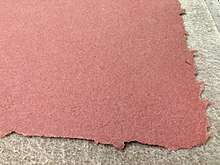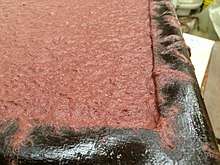Deckle
A deckle is a removable wooden frame or "fence" used in manual papermaking. In a related sense, it can also mean deckle edge paper—a type of industrially produced paper with rough cut, distressed edges used in the book trade.

| Look up deckle in Wiktionary, the free dictionary. |

Deckle frame
In hand papermaking, a deckle is a removable wooden frame or "fence" placed into a mould to keep the paper pulp slurry within the bounds of the wire facing on a mould, and to control the size of the sheet produced. The mould and deckle is dipped into a vat of water and paper pulp that has been beat (fibrillated). The pulp is quickly scooped out of the vat and the mould and deckle is shaken as excess water is drained off. The deckle is then removed and the newly formed sheet is "couched" (set) onto felts. Fiber that has been beat longer generally requires more time to drain. If the paper slurry gets under, or if long fibers settles on top of the deckle, it will cause a more irregular edge.[1]:119, 177–178
Deckle edge
Paper with a feathered edge is described as having a deckle edge, in contrast to a cut edge.[2] Machine-made paper may artificially have its edges produced to resemble a deckle edge.[1]:456, 458
Before the 19th century, the deckle edge was unavoidable, a natural artifact of the papermaking process in which sheets of paper were made individually on a deckle. The deckle could not make a perfect seal against the screen at the edges and the paper slurry would seep under, creating a rough edge to the paper. The deckle edge could be trimmed off, but this extra step would add to the cost of the book.[2] Beginning in the early 1800s with the invention of the Fourdrinier machine, paper was produced in long rolls and the deckle edge became mostly obsolete; although there was some deckle on the ends of the rolls, it was cut off, and the individual sheets cut out from the roll would have no deckle in any case.[2]
With the appearance of smooth edges in the 19th century, the deckle edge slowly emerged as a status symbol. Many 19th-century presses advertised two versions of the same book: one with edges trimmed smooth and a higher-priced deckle version, which suggested the book was made with higher-quality paper, or with more refined methods. This tradition carried forward into the 20th and 21st centuries. As of 2016 modern deckle is produced by a purpose-built machine to give the appearance of a true deckle edge by cutting a smooth edge into patterns. Many modern readers are unfamiliar with the deckle edge and may see it as a defect; for example, Amazon.com has left notes to book buyers clarifying that the deckle is not a flaw in the product.[2] A deckle edge is unrelated to the practice of unopened pages, in which a reader must cut open pages with a knife.[2]
Other uses
In film processing, deckles are die inserts that set the coating width of a slot die coater or the extrusion width of an extrusion die. They work by constraining the flow as the material exits the die. Since some materials have a tendency to neck in or spread out after leaving the die, workers may need to adjust the deckle position to achieve target width.
Deckle can also refer to the fatty part of a cut of brisket.[3]
A deckled edge is also a feathery, unfinished paper edge. Many fine art works, and hand-made, fine art finished, or digital prints deckle the paper edge. Again, as in book printing, this was once considered an imperfection as the byproduct of hand-made paper-making. Now makers use it to create the appearance of greater value.
See also
- Papermaking
- Extrusion coating
- Plastics extrusion
References
- Hunter, Dard (1978) [1947]. Papermaking, the History and Technique of an Ancient Craft. New York: Dover Publications. ISBN 0-486-23619-6.
- G.F. (Jul 15, 2012). "Deckle detecting". The Economist. Retrieved July 17, 2012.
- "Do you know your deckle from your flat? A glossary of brisket terms". Washington Post. Retrieved 4 August 2019.